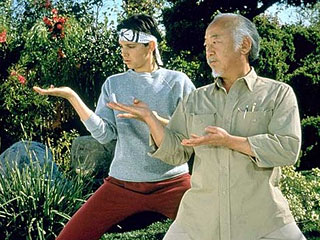
As a storytelling coach, I often hear the same question from students: How do I become a better storyteller?
As is the case with any pursuit, it all comes down to practice.
Storytelling is one of the most innate human activities – people tell stories in one form or another every day – but it takes work to hone your craft. So to help you shape your stories, here are “8 Steps to Improving Your Storytelling.†The exercises won’t turn you into David Sedaris, Spalding Gray or even Ralph Macchio (see above) overnight, but try these every day for a month and you’ll notice the benefits. And it’ll be way easier than learning to catch flies with chopsticks*.
- Keep a daily log. The first step to becoming a better storyteller is to record events as they happen. Set aside at least half an hour each day, preferably in the morning or late at night, to write in a journal. When you write, it’s important to stick to the facts as much as possible. Avoid passing judgements and drawing conclusions. Be specific (paint a picture), honest (don’t lie!), and personal (explore your stakes), and you’ll quickly find that the journal will become a source of material for stories.
- Sharpen your listening skills. Listen to the stories that your friends and family tell. Try to identify the component parts (character, setting, problem, stakes, conflict tension, crisis, climax, consequences) of every story. As I mentioned in a previous post, the fastest way to become a better storyteller is to become a better listener.
- Record and transcribe the story. One of the best ways to practice storytelling is to record yourself telling a story. Once you’ve finished, do something unrelated for an hour or so and then come back and transcribe the tape verbatim. The transcription process will help you identify verbal tics (‘um’, ‘uh’, ‘like’, etc) in your speech pattern and will offer insight into the strengths and weaknesses of the narrative.After you’ve read over the transcription, ask yourself: Does the story interest me? If I were a complete stranger, would I listen to the whole story? If the answer to either question is ‘No’, don’t despair. That’s where Step 3 can help.
- Outline the story. Once you’ve recorded and transcribed your story, outline the story. Break the story into scenes, draw pictures, or use a story map (see here and here). Experiment with different outline techniques and you’ll find one that works best for you.
- Turn the story into a pitch. You should be able to summarize your story in a one sentence pitch, so practice doing this with every story you tell. Pitches should be simple and should suggest big moments or events (i.e., “the time I almost failed out of college†or ‘the time I peed in my pants in front of my high school rowing teamâ€). The simpler the pitch (ten words or fewer) the better.
- Try a story out in a social setting. Pitch your story to friends in a social setting and see if anyone wants to hear the story. You’ll quickly figure out what your audience finds interesting. Once you’re feeling comfortable with the story, try performing it at an open mic.
- Identify a theme. As I’ve mentioned before, a theme (i.e. redemption, love, betrayal, etc) will often appear in a story after you’ve told it a few times. Once you become aware of the theme, edit the story so the scenes work in service of the theme or themes. You’ll be amazed at what happens when you take the time to edit properly.
- Add a new twist. After you’ve performed a story several times, add a new twist. Start in a different place or add in a new detail and see how your audience reacts. The change may or may not work for the story, but you’ll learn something in the process. And that’s the point, after all.
*I’ve never caught a fly with chopsticks
(Originally published at The Story Source.)

Commentary
Got something to add?